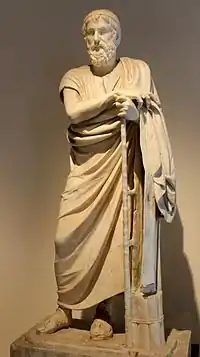nepenthes
See also: Nepenthes
English
WOTD – 4 June 2017

A statue of the semi-legendary Greek author Homer from the Villa of the Papyri in the ancient Roman town of Herculaneum, now in the collection of the Naples National Archaeological Museum in Naples, Italy. In Homer’s Odyssey (book IV, line 221), Helen of Troy places a nepenthes (sense 1) into some wine.

Nepenthes distillatoria, the type species of nepenthes (sense 2). A nepenthes is also known as a monkey cup or tropical pitcher plant.
Pronunciation
- (Received Pronunciation) IPA(key): /nɪˈpɛnθiːz/
Audio (UK) (file)
- (General American) IPA(key): /nəˈpɛnθiz/
- Hyphenation: ne‧pen‧thes
Etymology 1
Borrowed from Latin nēpenthes (“a drug bringing relief from grief”), from Ancient Greek νηπενθές (nēpenthés), neuter of νηπενθής (nēpenthḗs, “sorrow-banishing”), from νη- (nē-, “not”) + πένθος (pénthos, “grief”) (from πάσχειν (páskhein), present active infinitive of πάσχω (páskhō, “to be ill or injured in a certain way; to suffer”), from Proto-Indo-European *kʷendʰ- (“to endure, to suffer”)). Compare French népenthès (“a plant from which a drug supposedly bringing relief from grief may be obtained; such a drug”).
Noun
nepenthes (uncountable)
- A drug mentioned in Homer's Odyssey (c. 8th century B.C.E.) as bringing relief from anxiety or grief; hence, any drug or substance seen as bringing welcome forgetfulness or relief.
- 1549, Desiderius Erasmus; Thomas Chaloner, transl., “Folie Speaketh”, in The Praise of Folie. Moriæ Encomivm: A Booke Made in Latyne by that Great Clerke Erasmus Roterodame. Englisshed by Sir Thomas Chaloner Knight, [London: In Fletestrete in the House of Thomas Berthelet], OCLC 837100183:
- [A]ll ye (whom I ſee here preſente) doe fare as if ye were well whittled, and thoroughly moyſted with the Nectar wine of Homericall godds, not without a portion of that iuyce of that meruailous herbe Nepenthes, whiche hath force to put ſadneſſe and meloncholie from the herte: […]
- 1596, Edmund Spenser, The Faerie Qveene. Disposed into Twelue Books, Fashioning XII. Morall Vertues, part II [books IV–VI], London: Printed [by Richard Field] for VVilliam Ponsonbie, OCLC 932900760, book IV, canto III, stanzas XLII and XLIII, page 49:
- And in her other hand a cup ſhe hild, / The which was with Nepenthe to the brim vpfild. // Nepenthe is a drinck of ſouerayne grace, / Deuized by the Gods, for to aſſwage/ Harts grief, and bitter gall away to chace, / VVhich ſtirs vp anguiſh and contentious rage: / In ſtead thereof ſweet peace and quiet age / It doth eſtablish in the troubled mynd.
- 1624, Democritus Junior [pseudonym; Robert Burton], “Exercise Rectified of Body and Minde”, in The Anatomy of Melancholy: […], 2nd edition, Oxford, Oxfordshire: Printed by John Lichfield and James Short, for Henry Cripps, OCLC 54573970, partition 2, section 2, member 4, page 262:
- Read the Scripture […] T'is the beſt Nepenthes, ſureſt cordiall, ſweeteſt alteratiue, preſenteſt diuerter: […]
- 1845 February, — Quarles [pseudonym; Edgar Allan Poe], “The Raven”, in The American Review, volume I, number II, New York, N.Y.; London: Wiley & Putnam, […], OCLC 1015246566:
- "Wretch," I cried, "thy God hath lent thee—by these angels he hath sent thee / Respite—respite and Nepenthe, from thy memories of Lenore. Quaff, oh quaff this kind nepenthe and forget this lost Lenore!"
- 1876, John Davies, “[Tobacco.]”, in Alexander B[alloch] Grosart, editor, The Complete Poems of Sir John Davies. Edited, with Memorial-Introduction and Notes, by the Rev. Alexander B. Grosart. In Two Volumes (Early English Poets), volume II, London: Chatto and Windus, Piccadilly, OCLC 752538909, page 226:
- Homer of Moly and Nepenthe singes: / Moly, the gods most soveraigne hearbe divine. / Nepenth Hellen's drink, which gladnes brings,— / Hart's greife repells, and doth ye witts refine.
- 2013, Ogden W[illis] Rogers, “The Tipping Point (or, ‘There She Goes Again …’)”, in Beginnings, Middles, & Ends: Sideways Stories on the Art & Soul of Social Work, Harrisburg, Pa.: White Hat Communications, →ISBN, page 229:
- The nepenth of nostalgia is replaced by an amphetamine of anticipation.
-
- A Southeast Asian carnivorous plant of the genus Nepenthes; a monkey cup or tropical pitcher plant.
- 1863, Spenser [Buckingham] St. John, “Introduction”, in Life in the Forests of the Far East; or Travels in Northern Borneo. [...] With Numerous Illustrations. In Two Volumes, volume I, 2nd rev. edition, London: Smith, Elder and Co., page 11:
- And how marvellous were the shapes of the nepenthes, how beautiful the colour, how delicate in form!
- 1867, “NEPENTHA′CEÆ”, in Charles Knight, editor, Natural History or Second Division of “The English Cyclopædia”, volume III, London: Bradbury, Evans, & Co., 11, Bouverie St., Fleet St., E.C.; New York, N.Y.: Scribner, Welford, & Co., 654, Broadway, OCLC 61167125, column 1080:
- NEPENTHA′CEÆ, Nepenths, a natural order of Exogenous Plants inhabiting the damper and warmer parts of Asia, and having, in the place of leaves, large hollow bodies furnished with a lid, and containing water secreted from a peculiar glandular apparatus with which they are lined. […] [T]he adherent ovary of Birthworts, their highly developed calyx, axile placentation, and hermaphrodite flowers, are serious difficulties in the way of a close contact between them and Nepenths, unless the peculiar structure of the wood, the consideration of which I for the present abandon, should lead to the final establishment of the class of Homogens, in which case Nepenths and Birthworts will be brought into contact or at least a near neighbourhood.
- 1875 July 29, Lawson Tait, “Insectivorous Plants”, in Nature: A Weekly Illustrated Journal of Science, volume XII, number 300, London; New York, N.Y.: Macmillan and Co., page 252, column 2:
- When studying the nepenthes, I was puzzled to see the use of the channel which exists on the back of the pitchers, and which is formed by two ridges furnished with spikes in most of the nepenthes, but not in all, which run up to the margin of the lip of the pitcher.
- 2013, Anwar Shahzad; Taiba Saeed, “In Vitro Conservation Protocols for Some Rare Medicinal Plant Species”, in Mohd. Shahid, Anwar Shahzad, Abida Malik, and Aastha Sahai, editors, Recent Trends in Biotechnology and Therapeutic Applications of Medicinal Plants, Dordrecht: Springer, DOI:, →ISBN, page 265:
- Different techniques in plant tissue culture may offer certain advantages over traditional methods of propagation which include […] Production of plants from seeds that have very low chances of germinating and growing, i.e.: orchids and nepenthes.
-
Alternative forms
- (substance bringing forgetfulness or relief): nepenth (obsolete, rare), nepenthe (archaic)
- (plant): nepenth (obsolete, rare)
Synonyms
- (plant): monkey cup
Derived terms
- nepenthaceous (“belonging to the Nepenthaceae family of plants”)
- nepenthean
Related terms
- Nepenthaceae
- Nepenthes
See also
- (substance bringing forgetfulness or relief): amnesic
Etymology 2
nepenthe + -s.
Noun
nepenthes
- (archaic) plural of nepenthe.
Synonyms
- nepenths (obsolete, rare)
Further reading
 Nepenthes on Wikipedia.Wikipedia (genus of carnivorous plants)
Nepenthes on Wikipedia.Wikipedia (genus of carnivorous plants)